
New Items - Photos, page 6
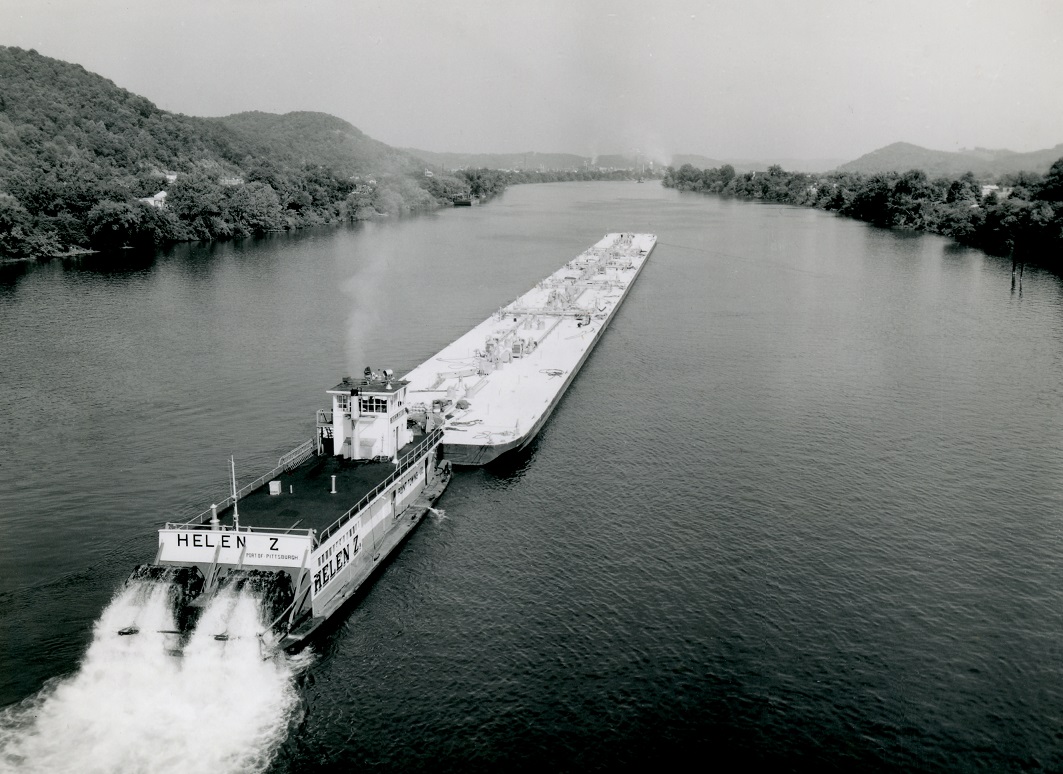
HELEN Z. Sternwheel Diesel towboat
Port of Pittsburgh
Point Towing Co.
Kanawha River
Photo by Everett R. Leadbetter
Scanned today from a 3-1/2 x 4-1/2 inch print (possibly a "proof" of the original negative)
OLD BOAT COLUMN
WATERWAYS JOURNAL
NOVEMBER 30, 2020
The Towboat Helen Z Remembered
BY KEITH NORRINGTON
Three steam towboats were built at Dubuque, Iowa, in 1911 for the Kansas City District of the U.S. Army Corps of Engineers. All were constructed on steel hulls measuring 137.6 feet in length by 24 feet in width with a depth of 5 feet. The condensing engines of these "sisters," named Lieut. Augustin, Lieut. Gurney and Lieut. Lewis, were 13's, 26's with a 5-foot stroke.
All three boats were later transferred to the Memphis district and in 1932 were taken to the Dravo Marine Ways at Neville Island, Pa., for rebuilding and to widen the hulls. The Lieut. Augustin was sold at public sale in 1939 to Charles Zubik at Pittsburgh, who renamed the vessel Helen Z and converted it to diesel power, with Fairbanks-Morse engines providing 450 hp.
Eventually, the Helen was sold to the Hillman Transportation Company, which again sold the boat in 1953 to General Barge Company at Pittsburgh. In 1959, the split-wheel sternwheeler again changed owners and went to Point Towing Company at Point Pleasant, W.Va. By 1968, the towboat was owned by M/G Transport Services at Cincinnati.
Five decades ago, the Helen Z was retired and donated for $1 to the New Albany, Ind., Jaycees, who planned to remove the boat from the river, place it atop some short piers that once carried the Southern Railway tracks along the waterfront, and use it as a clubhouse. The old paddlewheeler languished at the foot of the city boat launching ramp for months, much to the aggravation of pleasure boaters who were unable to use the facility. The civic project was fraught with numerous problems, and the boat sank during the winter.
Plans were being made to refloat the vessel when the spring flood of 1970 intervened, completely covering the boat. When the water receded, little remained but the hull and the engine room bulkheads. A towboat captain later told me that he had seen the pilothouse wreckage lodged high in trees near the site of old Lock and Dam No. 43, some 30 miles downstream. This writer (16 years old at the time) rummaged in the rubble remaining at the New Albany landing and salvaged a large oar with the boat's name stenciled on it and some unique paddlewheel pieces, including battens, stirrups and a cocked hat.
The city government eventually hired a demolition company to remove the doomed boat from the ramp, ending the saga of a stalwart sternwheeler.
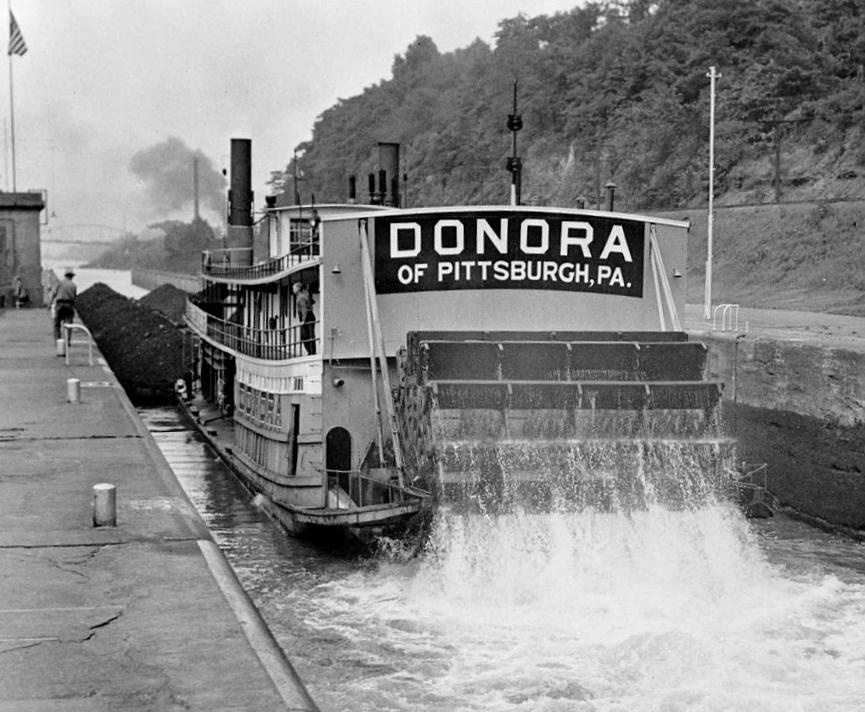
DONORA Sternwheel Towboat
DONORA
Sternwheel Towboat
Way's Steam Towboat Directory Number T0622
Built in Jeffersonville, Indiana by Howard Ship Yards, 1924
The DONORA had a deep, window-shaking whistle.
She was originally equipped to burn fuel oil but soon was changed to a coal burner. Although designed for Monongahela River work, she also worked on the Ohio and Mississippi rivers.
In 1924 she was first owned by the American Steel and Wire Company, Pittsburgh; which in 1929 merged with the Carnegie Steel Company and the DONORA went over to the Carnegie fleet.
She was leased in 1932 by Captain Jess Barbour and towed in the south for Louisiana-Texas Waterways Corporation.
Carnegie retired her about 1948 and dismantled her at Coal Valley, Pennsylvania in 1950.
Officers & Crew:
1927: Captain Tom Lewis (master), J.H. Hays (pilot), Martin Cloherty (chief engineer), F.A. Bunner (2nd engineer), Frank Mecks (mate); 1932: Captain Jesse Barbour, Captain "Chess" Wilcox (master)
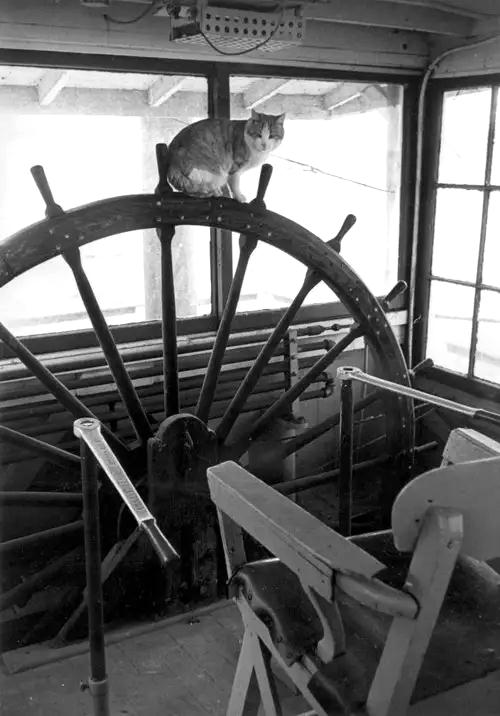
Kitty cat on pilot wheel in what looks like the pilot house of the towboat LONE STAR
Kitty cat on pilot wheel in what looks like the pilot house of the towboat LONE STAR
The cat may have been a mascot when the LONE STAR was still in operation or after
it was beached on the waterfront at LeClaire.
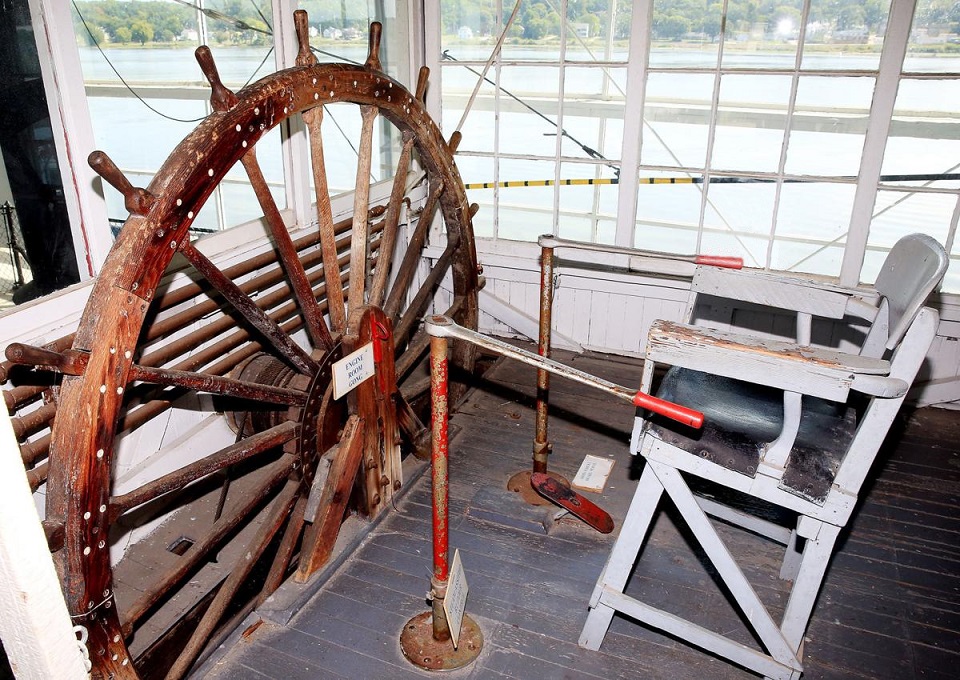
The Lone Star in LeClaire, the last of its kind
February, 2019
Updated Feb 2020
QUAD CITY TIMES
The Quad Cities is a region of five cities in Iowa and Illinois: Davenport and Bettendorf in Southeast Iowa, and Rock Island, Moline, and East Moline in Northwest Illinois.
With the sound of a paddlewheel splashing in water and shore birds chirping, you can close your eyes and imagine you're in the 1890s, riding a steamboat on the Mississippi River.
And if you're in LeClaire, inside the steel-and-glass enclosure that houses the 129-year-old Lone Star steamboat, you can open your eyes and see the real thing.
This vessel is the nation's only surviving wooden-hulled steamboat built in the traditional western rivers style, the kind that delivered all those pioneers and all those supplies to settle the West. It is listed as a National Historic Landmark by the National Park Service.
I invite everyone interested in what makes the Quad-Cities special to visit this boat, protected by an enclosure attached to the Buffalo Bill Museum. The significance of having a wooden hull is that wood has long been outlawed by the Coast Guard for safety reasons, and the significance of steam is that boats of its type switched to diesel mid-20th Century.
The boat dates to 1890, possibly earlier. It retired from active duty in 1967 when it could no longer pass a safety inspection.
If you're really lucky — as I was — you might run into the last person who piloted the boat, Glenn Johnson, just shy of 88 years old, and a resident of rural Prophetstown, Illinois. The former captain stops by the museum regularly and is happy to answer questions.
"There's probably people who could tell you more about it, but they aren't alive anymore," he chuckles.
At the time he piloted the boat — 1959 to 1967 — it was used to haul sand and gravel up and down the river.
"The normal run was to go from Davenport with (empty) barges up to above Cordova, almost Camanche, and dredge sand and bring it back," Johnson said. The sand was used to make redi-mix concrete; the trip included an overnight stay.
Being powered by steam meant that crew members had to load fuel into the boiler by hand and make sure the fire didn't go out. At first the boat was fueled by wood, then converted to coal.
Regardless, every so often, crew members known as "fire men" had to clean out the ashes, a task that was accomplished by opening a trap door and letting them fall into the river. (The outhouse-type toilets operated under the same principle.)
Water was drawn from the river, and every other week the boilers had to be shut down, drained and washed, Johnson said. In the spring when the river was muddier, the cleaning had to be done every week, he said.
The boat also was equipped with a steam powered dredge so that it could suck sand and gravel into its hull.
The Lone Star is entirely mechanical; there is no radar, no radio and certainly no computer technology. Communication among the crew was accomplished by a bell system. Mark Twain would have been familiar with the steering system.
Steamboats had to be inspected by the Coast Guard every year, and Johnson chuckles to remember the time inspectors told him the Lone Star didn't have its running lights in the right place.
On a diesel-powered boat they were in a different place than on steamboats, but the inspectors had never seen a steamboat before so they didn't know.
"They weren't up on their steam boats," Johnson said. "Times had changed."
And it tickles Bob Schiffke, executive director of the museum, to think of new boats sharing the same river as the Lone Star in the 1960s.
"At the same time modern towboats were going up and down the river in 1967, he (Glenn Johnson) was still operating as they had in 1896," Schiffke said. "With no radio and no radar. Just bells and yelling."
After the boat was retired it was dry-docked in LeClaire as a tourist attraction, but by 2006, it was literally falling apart from dry rot. Schiffke was making repairs at the time and "realized it was almost a lost cause, sitting out in the open."
Visitors couldn't even get to the pilot house because the rotting wood made it too hazardous. Schiffke put down some board with a railing so that people could walk over the damaged areas, but something more permanent needed to be done.
Supporters formed a committee and began fund-raising. Major contributions came from the city of LeClaire and the state of Iowa, as well as Scott County, the Regional Development Authority, the Scott County Regional Authority and many individuals. In two years, the $1 million enclosure with a concrete floor opened to the public.
Visitors will see that some wood on the boat is extremely cracked and weathered and some is new. The new, particularly on the front is 2-inch-thick maple planking that Schiffke and his grandson, Michael Schiffke, installed because the boat's boiler was beginning to fall through the floor.
And about that sound of the paddlewheel splashing and birds chirping?
Ah! That is the latest addition to the exhibit, a five-minute loop of audio to provide a more realistic experience.
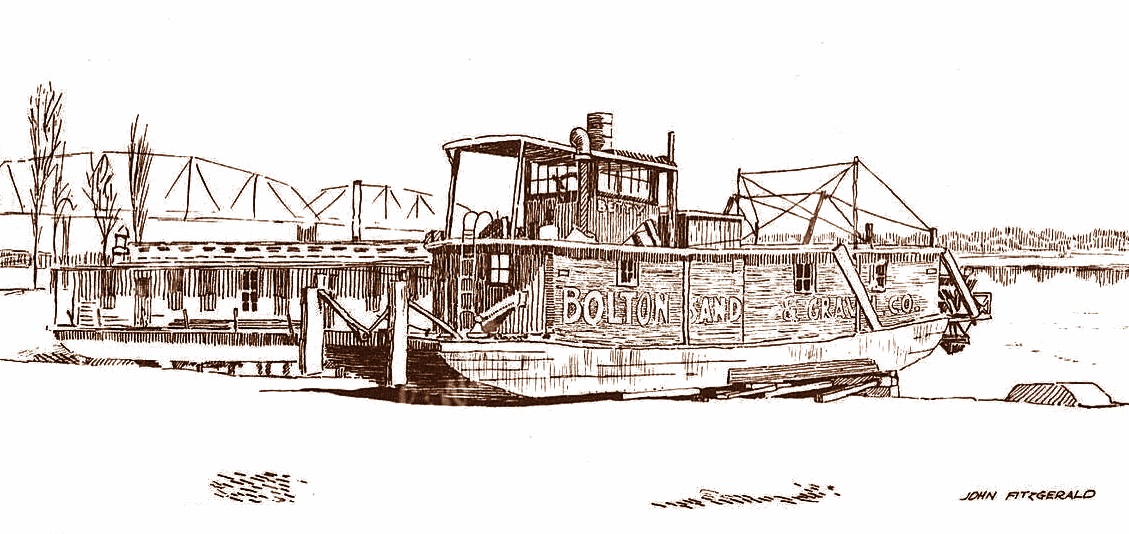
Towboat BETTY that worked for the Bolton Sand & Gravel Co. Hannibal, MO.
Detail from a Drawing by John Fitzgerald entitled "Riverfront Boat Hannibal, Missouri" of the small utility Towboat BETTY beached on shore. BETTY worked for Bolton Sand & Gravel Co. In the distance on the left is the Mark Twain Memorial Bridge that crossed the Mississippi to Illinois.
Published by "Pen Tone Line" ~ Jefferson City, MO (undated)
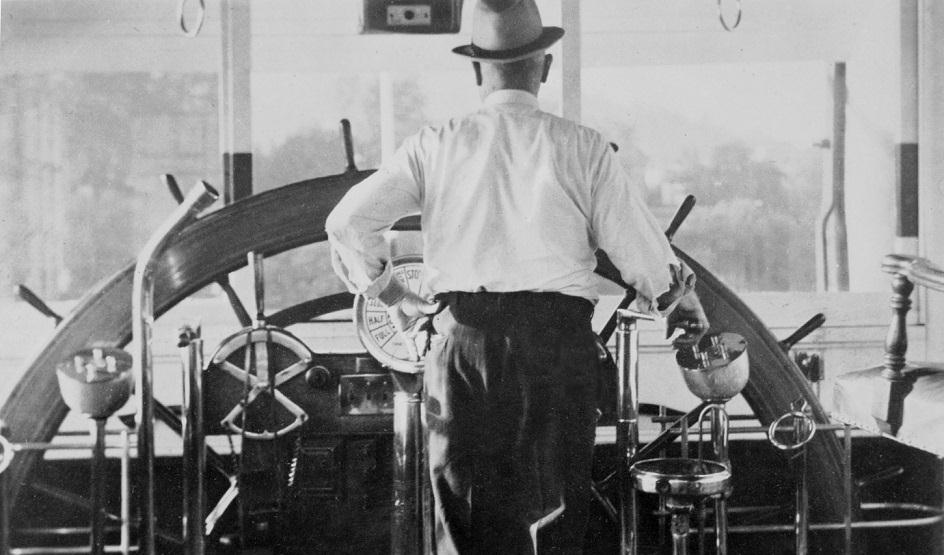
Pilot at wheel . . . Towboat J.H. Hillman (1927-1951)
J.H. Hillman
Sternwheel Towboat
Way's Steam Towboat Directory Number T1253
Built in 1927 at Ambridge, Pennsylvania
Owned by 1927: Hillman Transportation Company
June 1951: Zubik Towing Company
Ran the Monongahela River
During her time with Hillman Transportation Company, she spent her days towing coal.
She was one of the best towboats in the pools.
Under charter to UBL, she made at least one trip to New Orleans (December, 1939).
She was sold in June, 1951 to Zubik Towing Company, Pittsburgh and then decommissioned
Officers and Crew
1927:
Captain Elmer E. Culp (master), James A. Downer (pilot), Edward Miller (mate), Van Petty (chief engineer).
Thomas Surrett (2nd engineer)
Later:
Frank Silliman (chief engineer), John Silliman (2nd engineer)
1930's:
Captain John M. Hudson (master), John Silliman (chief engineer)
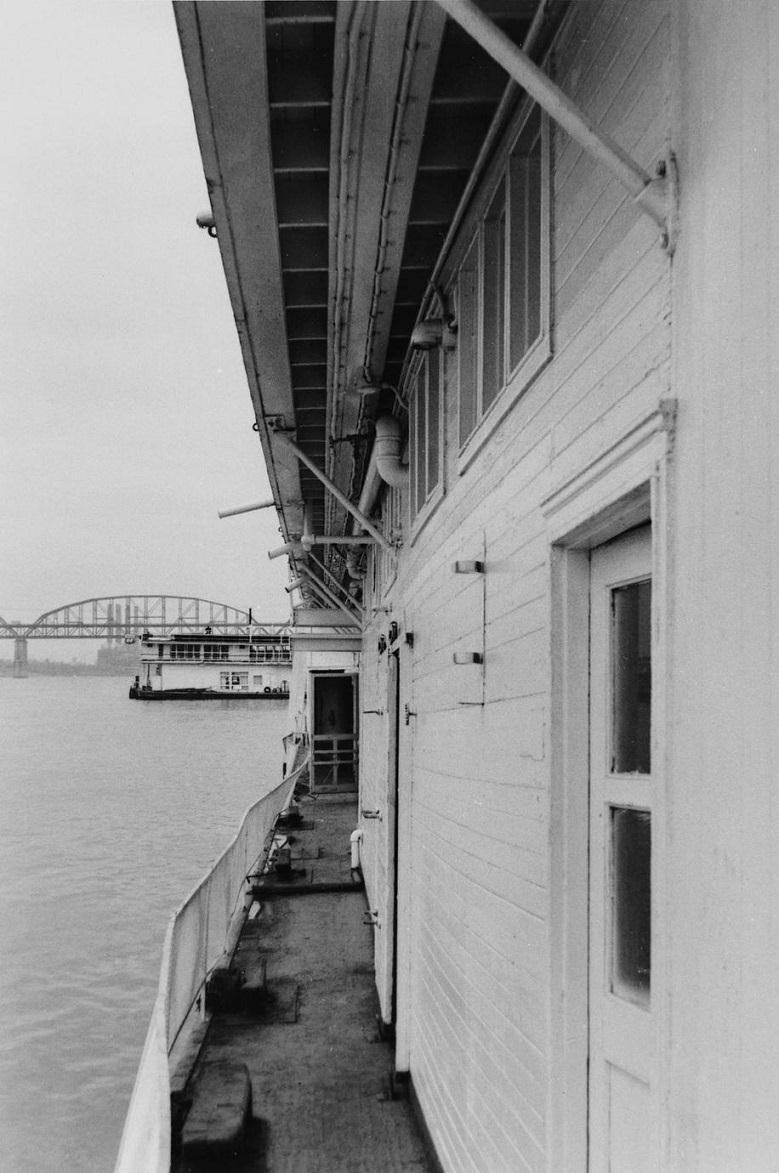
board the MISSISSIPPI (later became the BECKY THATCHED)
UNUSUAL SNAPSHOT FROM LA CROSSE TAKEN
ON THE MAIN DECK OF THE MISSISSIPPI BEFORE
SHE BECAME THE BECKY THATCHER
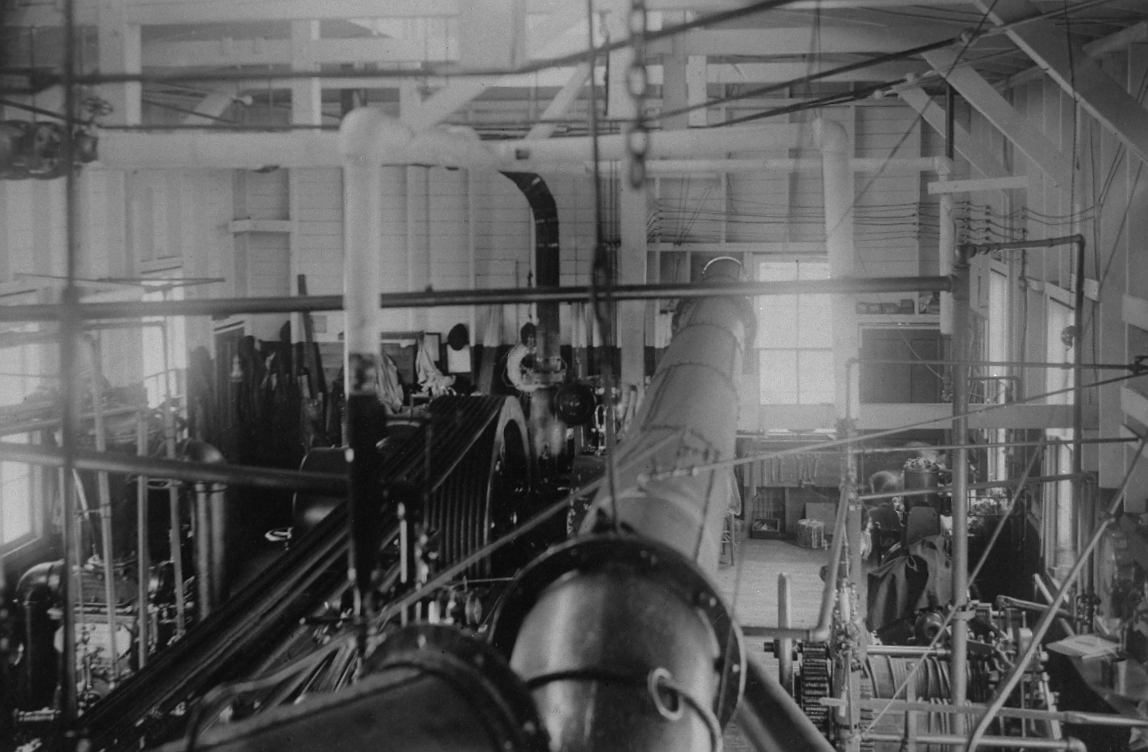
The Engine Room of an unidentified hydraulic dredge
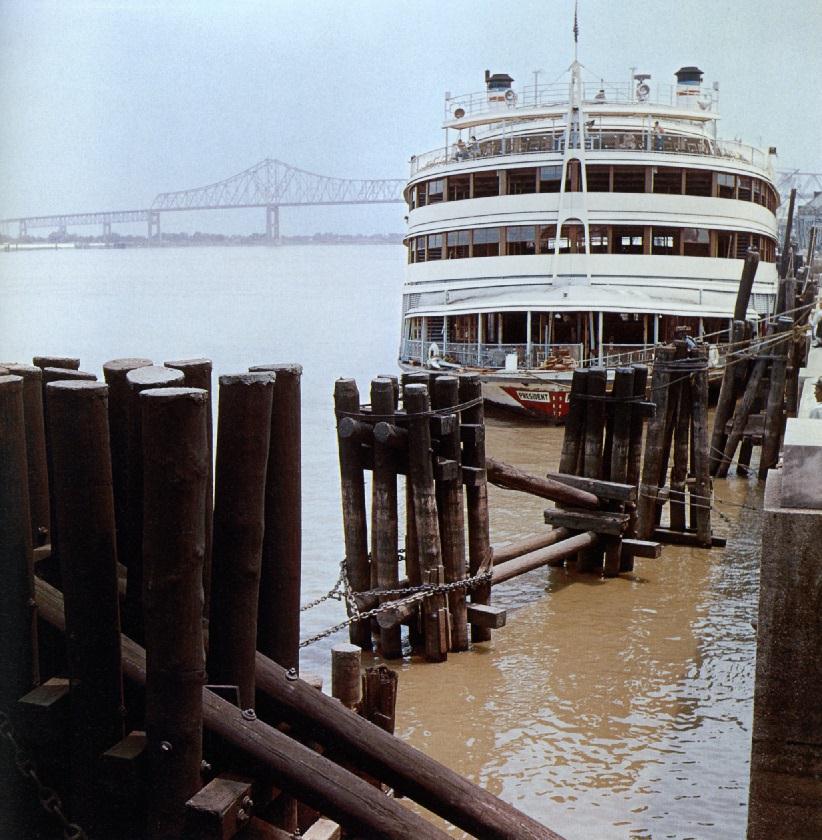
Page 155 Riverboat PRESIDENT in New Orleans harbor
From the book:
New Orleans Jazzlife 1960
William Claxton Photographer
Joachim E. Berendt Writer
Published by TASCHEN 2006
A love letter to the birthplace of Jazz, New Orleans will never again appear as it does in these rare and stunning photographs by William Claxton taken for the book Jazzlife in 1960. While traveling around the U.S. with Musicologist Joachim E. Berendt to record America's original art form, Claxton met and photographed the jazz personalities in every major and minor city, capturing these musicians in their natural environment.
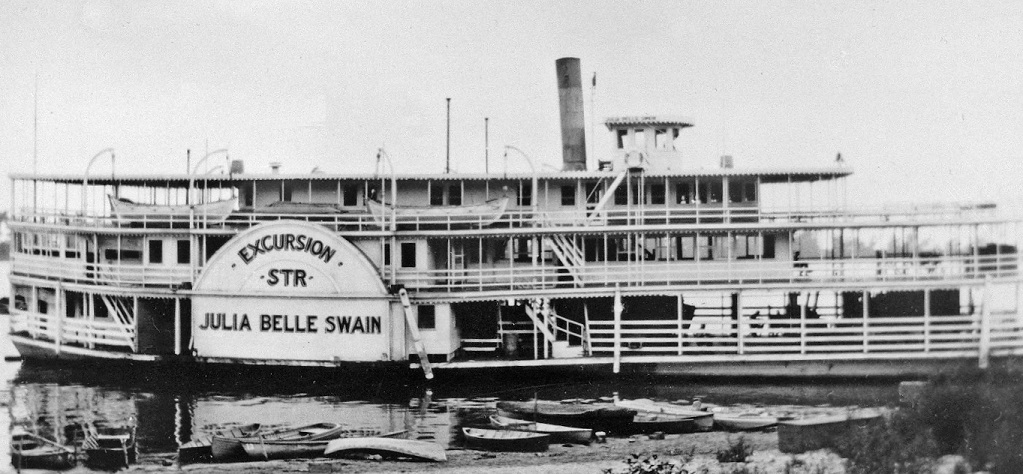
The "original" JULIA BELLE SWAIN 1917 to 1931
JULIA BELLE SWAIN
Sidewheel Packet/Excursion boat from 1917 to 1931
Way's Packet Directory Number 3179
Built in 1913 at Santa Rosa, Florida as the CHARLES E. CESSNA (1913)
Owned by the Swain family and under the command of Captain Percy Swain beginning in 1917.
Ran the Illinois; Allegheny; Mississippi; Ohio and Monongahela rivers
The Swain family was involved in her construction and repossessed her in 1916.
They brought her to the Illinois River and there renamed her JULIA BELLE SWAIN .
She was used in packet and excursion work until sold in April 1924.
She was the last steamboat to be owned by the Swain family.
The new owners Edward M. Cody and Captain Oscar A. Moore/Penn Excursion Company
took her to Pittsburgh in 1924.
She burned in her winter quarters on the Monongahela River in December 1931.
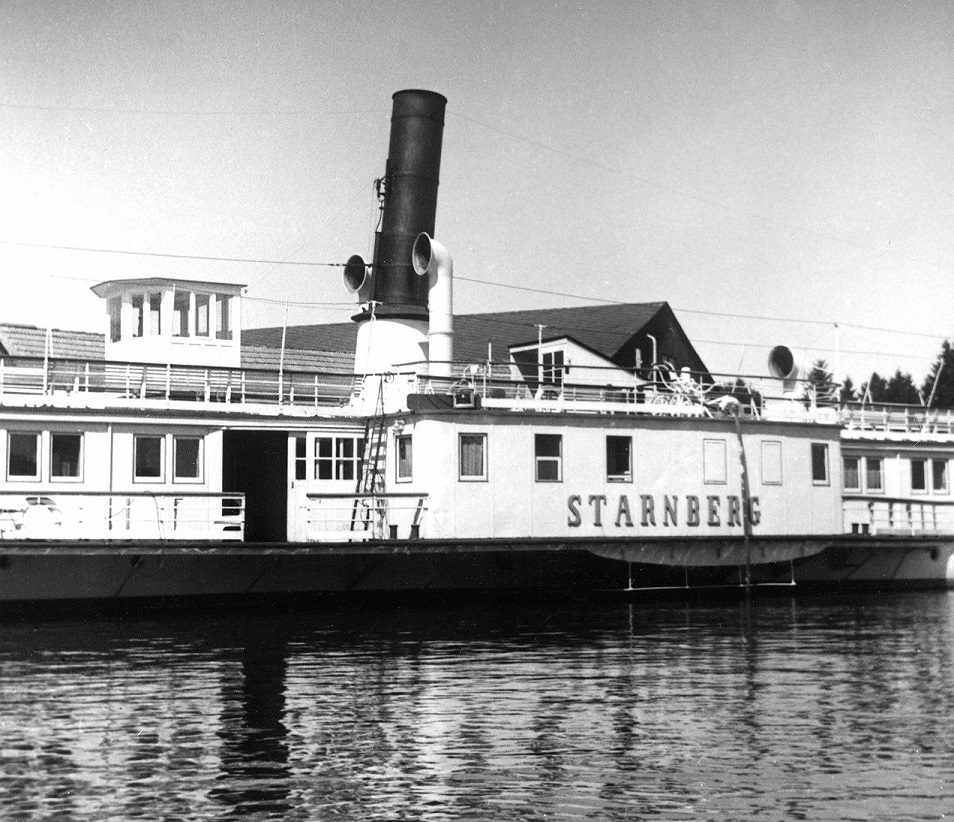
German sidewheel steamboat STARNBERG
World War II snapshot of the German sidewheel steamboat STARNBERG captured by the Allies on Starnberg Lake, Germany, 1945.
Lake Starnberg, or Starnberger called Lake Würm, or Würmsee until 1962 - is Germany's second-largest body of fresh water, having great depth, and fifth-largest lake by area. Located in southern Bavaria 16 miles southwest of Munich, Lake Starnberg is a popular recreation area for the city and, since 1976, one of the wetlands of international importance protected by the Ramsar Convention.
Passenger ferries and excursion ships have operated on the lake since 1851. Today they are operated by the Bayerische Seenschifffahrt company, using modern diesel-engine ships.
The lake and its surroundings lie in three different Bavarian districts, or Landkreise. The lake is the property of the state and accordingly managed by the Bavarian Administration of State-Owned Palaces, Gardens and Lakes.
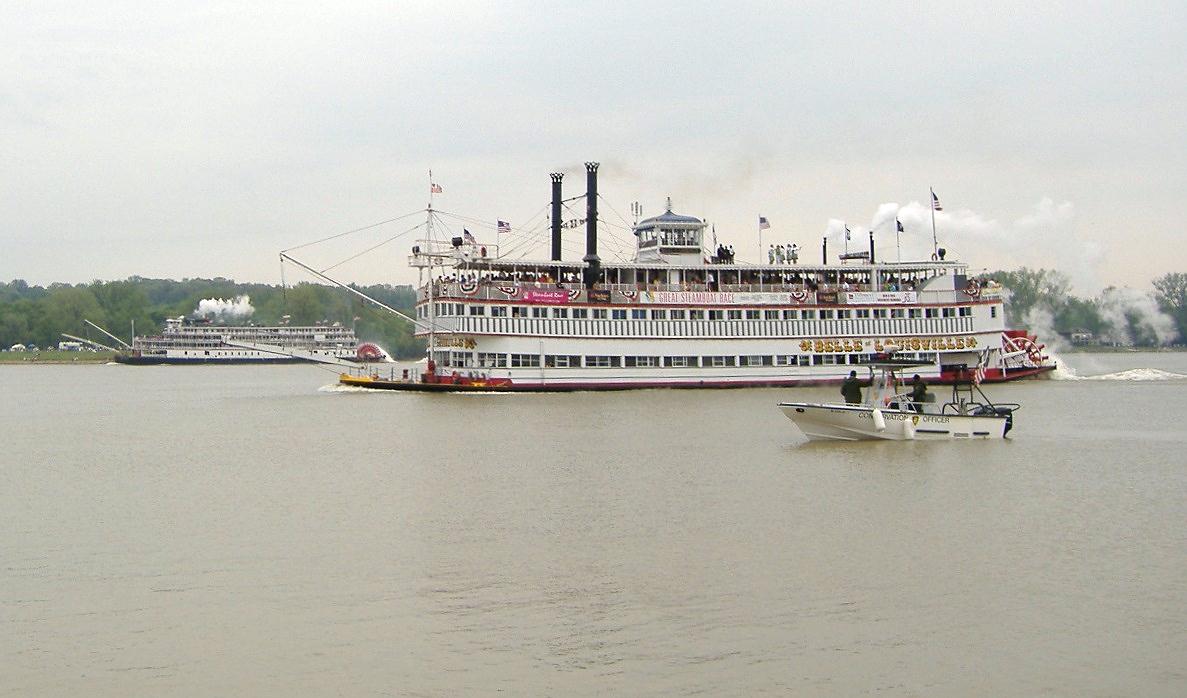
BELLE OF LOUISVILLE during Great Steamboat Race with DELTA QUEEN detail from Wikimedia photo

With the exception of images credited to public institutions,
everything on this page is from a private collection.
Please contact Steamboats.com for permission for commercial use.*
All captions provided by Dave Thomson, Steamboats.com primary contributor and historian.
